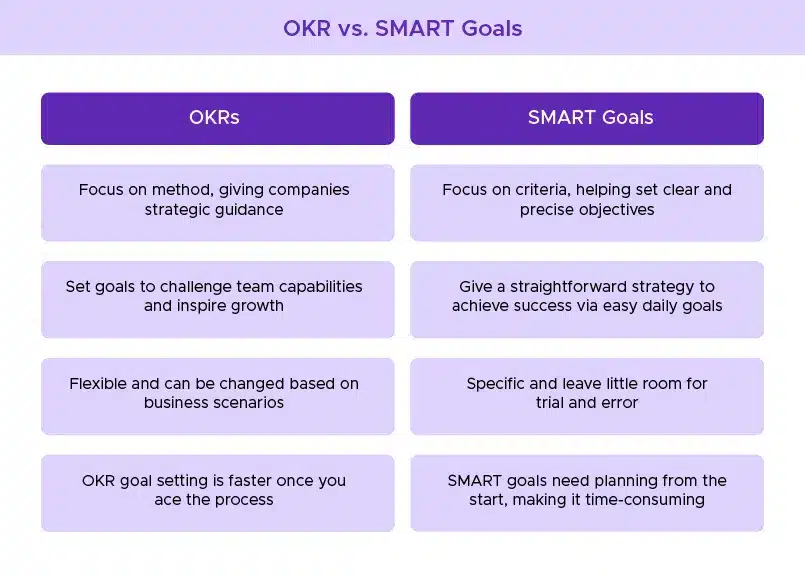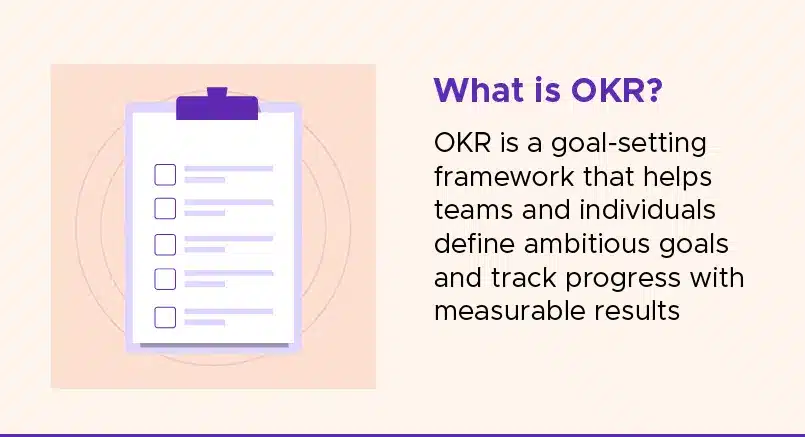When it comes to goal-setting methodologies, two prominent frameworks, OKR and SMART Goals, stand as beacons guiding organizations towards achieving ambitions.
Which among of them will be right for my organization ?
Why OKRs are better than smart goals?

What is the difference between goals and objectives?
Goals are broad, long-term aspirations that provide overall direction, while objectives are specific, measurable, and time-bound steps that serve as the building blocks to achieve those goals.
While, goals define the desired outcome, while objectives outline the actionable and quantifiable targets to track progress and success
Are you facing a similar dilemma? If so, read on and learn about different aspects, differences and usability of OKRs and smart goals.
OKR vs SMART goals: What do they have in common?
Even though organizations use SMART goals and OKRs competitively, they share many similarities. Given below is a list of features that both these frameworks have in common.
1. History and origin
Both OKRs and SMART Goals have their roots in the theory of Management by Objectives (MBO). The theory gained popularity in 1954 after Peter Drucker published it in his book. Both these frameworks are a developed form of MBO. They believe that goal setting is essential for ensuring organizational success.
2. Are specific
OKRs and SMART goals, both aim to remove ambiguity from objectives. They focus on setting clear and precise objectives that help employees stay focused. Such goals also provide teams with a sense of direction to unite their efforts.
3. Goal fulfillment
OKRs and SMART goals believe in creating a well-defined action plan for fulfilling objectives. The plans should be specific and time-bound. They should help organizations measure progress and correct course if needed.
4. Implementation
OKRS and SMART goals are both implemented informally. Their implementation is not monitored by any governing body or certification program. This helps to enhance the flexibility and effectiveness of both of these goal-setting frameworks.
5. Proper structure
OKRs and SMART goals both contain various criteria that help define their structure. They both follow specific rules for setting the scope of objectives, defining time frames, and ensuring alignment.
OKR vs SMART goals: what is the difference?

Despite their similarities, OKRs and SMART goals have different approaches to goal setting. The main point of difference between the two, include the following:
OKRs focus on method and SMART Goals on criteria
OKR focus on ensuring overall business growth. They provide strategic guidance for organizations to reach from point A to point B.
Companies using the OKR framework assess the progress of their teams toward each Key Result. They can set new Key Results under specific objectives to keep the teams motivated.
The SMART goals framework is more like a set of guidelines that helps companies set clear and precise objectives. It offers the criteria for creating small, individualistic goals focused on specific areas. Here are some employee smart goal examples that you should know.
While these goals are further shared by different departments, they are not driven by a single major objective.
OKRs are inspirational and aggressive and SMART goals are simple
OKRs focus on setting goals to challenge team capabilities and advance their potential. They push team efforts by setting long-term and ambitious objectives that inspire growth.
While the goals set through OKR are not impossible, they are stretched to achieve them completely. Hence, even a 70% success rate is good enough with this framework.
SMART Goals provide a more straightforward strategy for attaining success through simpler goal-setting. The framework creates everyday goals that are less complex and easy to fulfil.
The simplicity of objectives makes fulfilling them necessary for completing the process.
OKRs offer greater flexibility while SMART goals are specific
Companies using OKRs have an opportunity to change their goals according to business scenarios as they are mostly set for 60 or 90 days.
The best example to this is when COVID hit in 2019 companies using OKRs were able to change their objectives and goals according to the situation and found it less challenging to adapt to situations.
The Key Results can also be changed as per the changing business needs. Any pending Key Results are rolled over into the next cycle with some necessary changes. They also help organizations stay focused on critical business objectives.
SMART goals are very specific. This means that they focus on achieving the exact goals that they help to create. It is also important to fulfil the SMART goals within the set deadline.
This leaves little room for trial and error or even failure. So, companies using the SMART goal framework need to be sure that the goals being set are attainable.
OKRs encourage constant momentum and SMART Goals are rigid
OKR makes it necessary for companies to assess team progress towards key results. Companies can then revise the Key Results to encourage consistent momentum within teams.
It provides freedom to experiment with goals to create a more aspirational vision.
SMART goals focus on one concrete business metric to set goals. The goals are then divided into smaller sub-goals that make measuring progress easier.
For this, constant feedback is sought from teams and individuals. The feedback provides an insight into how well they are progressing with goal fulfilment.
OKR goal setting is faster while SMART goals take time
Writing or setting OKRs initially can be time consuming, but once you have aced the process, it is easy to frame the objectives.
Companies can analyze the OKR goals to check for any scope for improvement before they implement them. They are also able to find the best ways to incorporate the improvement factors.
This creates a continuous and flexible method with ample scope for experimentation and risk mitigation.
SMART goals need to be properly planned right from the beginning. This makes the process of setting goals extremely lengthy and time-consuming.
Companies need to factor in the best ways to fulfil objectives, measure progress, and keep the teams motivated. Yet, once the goals are set, fulfilling them becomes relatively easier and faster.
OKR vs SMART goals: strengths and weaknesses
Both OKRs and SMART goals have their strengths and weaknesses. Learning about them is essential for making the right choice between these two frameworks. Given below are the most important strengths and weaknesses of OKR vs SMART goals.
Ambitious
OKR helps to set more inspirational and ambitious goals to drive business success. OKRs help businesses to reach out into unchartered territories with an acceptance of failure.
SMART goals are designed to achieve specific objectives as planned and within the set time. So, while OKRs help to enhance company performance and efficiency, SMART goals are more straightforward and focus on improving specific business aspects.
Aspiration
Since SMART goals focus only on specific aspects of a business, they have a narrow focus. This makes employees overlook any other objectives or tasks that can bring greater profit.
OKRs focus on broader objectives created at the organizational level. This helps employees and teams to stay focused on the big picture and allows them to change tactics to maximize the chances of success.
Morale
In SMART goals, the inability to ensure 100% success in goal fulfilment, is considered a failure. This can be extremely demotivating for the employees and make them lose interest in the objectives.
OKRs accept failure as a part of the goal fulfilment process. Hence, the morale of employees is not affected even if they are not able to achieve all objectives successfully.
Accuracy
SMART goals focus on specific metrics and precise time frames and hence are more accurate and precise. They are created after extensive planning and hence take are quite time-consuming.
However, OKR objectives are created with a wider scope and allow for changes in Key Results in specific situations. So, this makes the OKR objectives less precise.
Consider the following examples to better understand the difference between OKR vs SMART goals.
Also Read : OKR vs Balanced Scorecard
Examples Of SMART Goals
Travel company and its SMART Goals strategy
A travel company uses SMART goals to increase its website traffic by 25% by December 2022. It plans to create social media campaigns for generating more online traffic and increasing website visits.
Specific: Increasing the number of visitors by 25%
Measurable: Increasing number of visitors from 1,00,000 to 1,25,000
Achievable: The social media and content strategy has been put in place by the inbound marketing team. An additional team of experts have been hired for increasing web traffic and visibility.
Relevant: The more the traffic, the more the customers, the larger the reach and the larger is the revenue
Time-bound: Complete the goal by December 2022
Telecom company and its SMART Goal strategy
A Telecom company sets the goal of improving the response time to handling customer complaints by 25% in the next year
Specific: Improving the response time to handling and resolving customer complaints by 25% in a year’s time.
Measurable: Increase the customer support and customer service staff from 3 to 10. The decrease in the number of pending complaints and increase in the number of satisfied customers can be used to measure the growth.
Achievable: A new office space has also been taken for accommodating the increased number of staff members
Relevant: A good responsive customer service desk helps in maintaining the customer base and even growing the client base
Time-bound: Achieve the target rate in a one year time.
Examples Of OKRs
Here is an annual OKR example of a startup –
| Objective | KR1 | KR2 | KR3 |
|---|---|---|---|
| Skyrocket the revenue targets | Acquire 10 Enterprise Customers | Generate 5 Mn USD from Upsell | Hit 30 Mn USD in Revenue |
| Build a product that our customers love | Achieve NPS of 70 | Improve G2 Rating from 4.1 to 4.8 | Increase the daily active users by 100% |
OKR vs SMART goals: which will be right for you?
Different organizations use different approaches to set goals aimed at enhancing organizational growth. Setting and implementing goals effectively helps to align teams and drives business success.
Effective goal setting provides direction to teams besides improving employee focus and motivation. It also helps measure the progress of teams and employees towards goal fulfilment.
OKR and SMART goals are two popular goal-setting methodologies used by organizations. Both these frameworks help organizations create realistic, precise, and time-defined objectives.
This makes choosing between OKR vs SMART goals quite difficult. The best way to overcome this dilemma is by learning about the different aspects of both these frameworks.
Why OKRs

Choosing the right goal-setting framework is essential for achieving the desired growth outcomes.
Since OKR turns goal-setting into a company-wide process, it is most suitable in the following situations.
OKR proves to be a better framework for companies that are well aware of what they want to achieve.
Having a clear understanding of where they want to be at the end of a quarter or a year is essential for setting realistic objectives.
It also helps teams to focus their efforts on fulfilling these objectives.
OKR proves beneficial for companies that need to track the progress of their teams.
Companies can track the changes in objectives and Key Results through weekly review meetings.
This helps them to revise or drop Key Results that are no longer relevant.
OKRs are best for setting objectives at organizational and team levels.
This helps companies to align teams across the entire organization to fulfilling them.
It also helps to improve the coordination between teams and besides builds a positive company culture.
OKRs are suitable for creating multi-metric goals.
This is due to their ability to have several Key Results. Each Key Result has a specific metric that sets the standard for the team to work for.
These multiple standards enable the team to work together to achieve organizational objectives.
But OKRs do fail if not implemented properly. Check out the blog to know why okrs don’t work and fail.
Why SMART goals?
SMART goals framework has its unique qualities and offers the best benefits in the following situations
SMART goals are the right choice for companies trying to implement top-down strategies. These strategies aim to improve workforce performance and behaviour. In such cases, the team managers motivate their juniors by leading by example.
Many times, companies are not sure about what they want to achieve by the end of the year. SMART goals help such organizations to set clear and precise objectives according to a fixed timeline.
SMART goals come in handy while setting objectives for teams and individuals. These objectives may be important for the people they are set for but may not contribute directly to organizational goals.
They aim to enhance team efficiency or draw out specific behaviour among individuals for better business growth.
Why SMART goals fail?
The key to understanding why SMART goals fail is to first understand that SMART Is an acronym, which makes it more susceptible to change. Some key reasons why these goals fail include the following.
Zero emotional connect
SMART goals are simple and do not offer any scope for people to establish an emotional connection. This makes them less likely to motivate people and drive their efficiency.
All or nothing approach
SMART goals are not completed unless people do everything as planned. The failure to achieve even one aspect of the goal discourages people and makes them give up on the entire objective.
Poor focus on future
Goal setting helps companies to envision a better future and assured growth. Sadly, SMART goals are not future-focused and this can hinder business growth.
Goals are not challenging
SMART goals framework focuses on creating objectives that can be easily achieved. This makes the goals less challenging and prevents employees from moving out of their comfort zone to fulfill them.
Narrow focus
SMART goals are focused on single specific objectives and it is the only aspect that employees and teams pay attention to. This creates an extremely narrow range of focus for employees which can diminish their sense of competition.
Success stories of companies using SMART goals
Despite its shortcomings, the SMART goal framework is helping several businesses to set goals to achieve greater success. Here are some success stories of companies that use SMART goals to improve their business.
Ambrosia Treatment Center
Ambrosia Treatment Center is a rehab centre based in Florida. It offers treatment for drug and alcohol addiction. According to its President of Business Development, Jerry Haffey Jr., the centre uses SMART goals for business improvement.
The framework helped the centre to successfully set and achieve its goal of giving away 1500 days of free treatment in 2016.
They increased the number to 1860 days in 2017. For this, they worked in collaboration with various advocacy groups and industry experts.
By 2018, the centre increased the number of free treatment days to 2000. Using the SMART goal framework enabled Ambrosia Treatment Center to expand its reach and help those who need it the most.
Power Digital Marketing
Power Digital Marketing is a company offering digital marketing and growth solutions, enabling client businesses to reach their full potential.
Grayson Lafrenz, the CEO of Power Digital Marketing, believes that SMART goals are the only types of goals. The company has been using SMART goals with consistency and differing cadences.
It uses the framework to set weekly goals and annual goals for individuals and teams.
The goals are important to both individual employees and the organization as a whole. As the employees and teams achieve the goals set for them, they pave the way for organizational success.
Success stories of companies using OKRs
“OKRs are clear vessels for leaders’ priorities and insights.” John Doerr.
OKRs have become a popular choice for goal-setting frameworks. This is due to its ability to offer seamless execution and outcomes. The success stories of companies using this framework are given below.
Huawei
Huawei is amongst the leading telecom companies across the globe. It has only recently started using OKRs to enhance its business practices for better growth and success. The company uses OKRs to set goals for employees working in different teams. These employees were able to identify and understand the significance of these goals. They were also aware of the contribution of these goals in ensuring overall organizational growth. This helped to improve business performance by aligning employee objectives. It also resulted in better collaboration among the workforce and motivated them to work collectively to achieve large organizational goals.
LinkedIn’s case study with OKRs is one of the foods of thought for the leaders. The giant used OKRs and linked them to the company’s objectives in a unified direction. The company started with 3 to 5 stretched and achievable OKRs and set up the measurable objectives as well as key results which can be reviewed on a weekly, monthly or quarterly basis. With the unique system of meetings for the purpose of tracking the team and individual’s OKR, clarity of scope and purpose at the macro level was achieved. Read the detailed case study here.
To read more success stories of companies using OKRs click here.
Summing Up
Hope by now you are able to differentiate between OKR vs SMART goals.
To get more information on OKRs – read our blogs on OKRs and download our OKR Ebooks.







